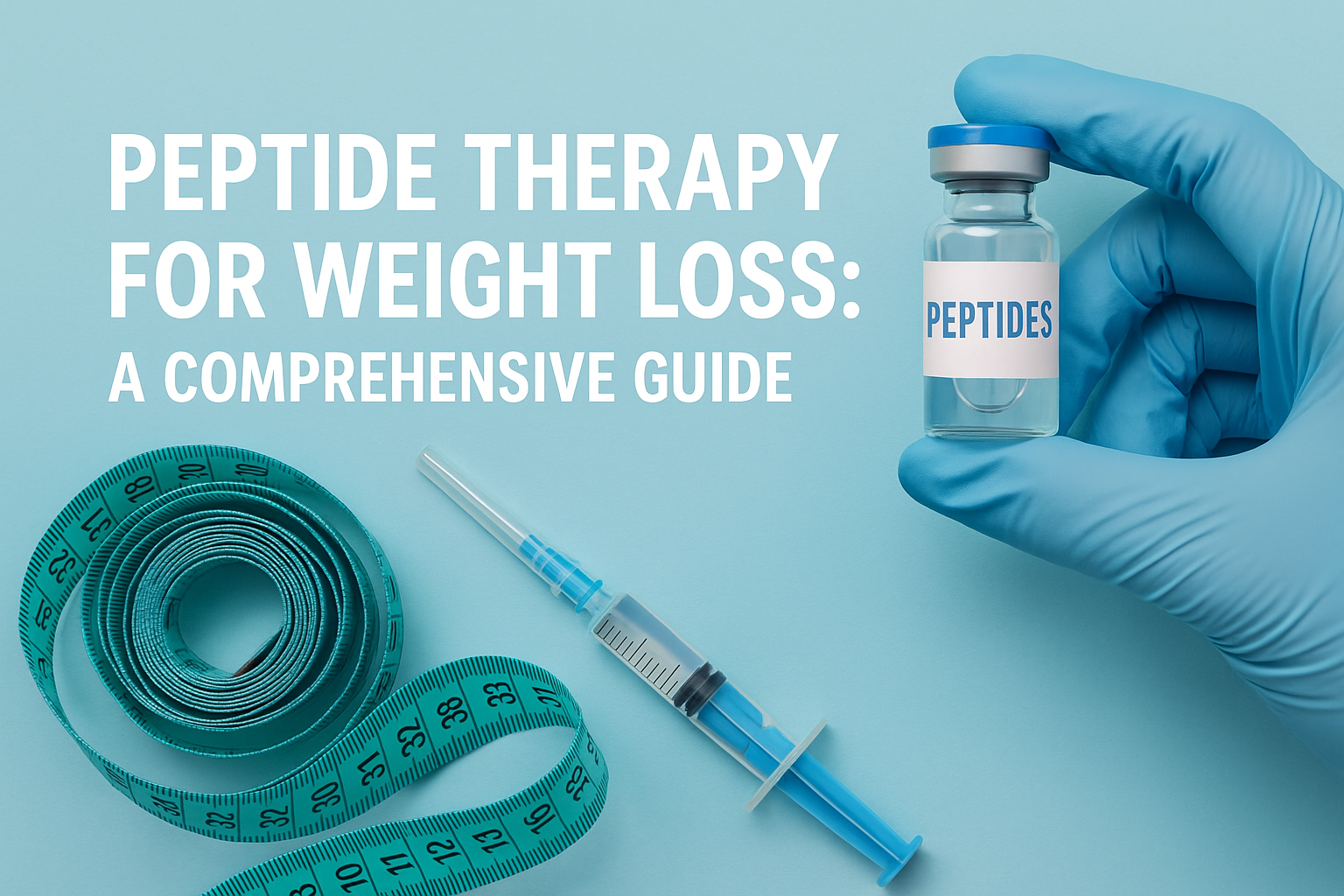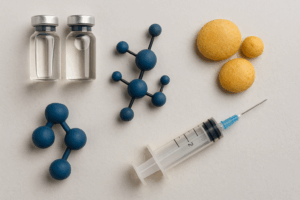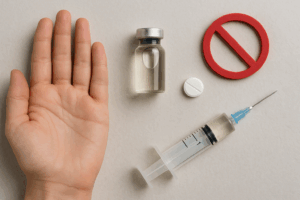Peptide Therapy for Weight Loss: Science-Backed Benefits, Key Peptides, Safety & Future Outlook

Peptide Therapy for Weight Loss: A Comprehensive Guide
Introduction
Obesity remains a global health challenge affecting millions, driving the search for effective, sustainable weight loss strategies. Among emerging medical interventions, peptide therapy has gained prominence as a sophisticated approach that harnesses small chains of amino acids to regulate metabolism, appetite, and fat utilization at the cellular level. Unlike traditional weight loss drugs, peptides mimic natural hormones to produce targeted, bio-compatible effects, offering promise for better long-term outcomes.
This article provides an in-depth overview of peptide therapy for weight loss, highlighting the key peptide classes, clinical efficacy, safety profiles, administration protocols, and challenges including cost and accessibility. We also compare peptides with other weight loss treatments and discuss future research directions.
What is Peptide Therapy for Weight Loss?
Peptides are short chains of amino acids that act as signaling molecules regulating various physiological functions. In weight loss, peptides influence mechanisms such as:
- Appetite control by modulating hunger and satiety hormones
- Metabolic enhancement through increased thermogenesis and fat oxidation
- Improved insulin sensitivity to reduce fat storage
- Fat breakdown (lipolysis) and prevention of new fat formation (lipogenesis)
Their ability to biomimic natural bodily processes positions peptides as advanced pharmacological tools, enabling the body to more effectively shed fat while preserving lean muscle mass.
Key Peptides Used in Weight Loss Therapy

Peptides under investigation for weight loss broadly fall into these categories:
1. GLP-1 Receptor Agonists
The most clinically validated and widely approved peptides for weight loss are GLP-1 receptor agonists, including:
- Semaglutide (Wegovy/Ozempic/Rybelsus): Mimics human GLP-1 to reduce appetite, slow gastric emptying, and improve insulin secretion. Clinical trials show average weight loss of 15-20% over 68-72 weeks.
- Liraglutide (Saxenda/Victoza): Similar mechanism with slightly lower efficacy, achieving about 5-6% weight loss in trials.
- Tirzepatide (Zepbound/Mounjaro): A novel dual agonist targeting both GLP-1 and GIP receptors, showing superior weight loss results (up to 25%) by activating multiple metabolic pathways.
These peptides work by acting on receptors in the brain, pancreas, and gut to reduce hunger and improve glucose metabolism.
2. Growth Hormone-Releasing Peptides (GHRHs/GHRPs)
These peptides stimulate endogenous growth hormone release, which can aid fat loss and muscle preservation. Examples include:
- Sermorelin
- CJC-1295 (with/without DAC)
- Ipamorelin
They increase metabolism, enhance lipid utilization, and promote tissue repair but have less direct evidence for weight loss compared to GLP-1 agonists.
3. Other Investigational Peptides
- AOD-9604: A fragment of human growth hormone focused on fat metabolism; preclinical data is promising, but clinical trial results in humans are inconsistent.
- Ghrelin and Leptin analogs: Target hunger and satiety signaling.
- Peptide YY (PYY), Melanocortin peptides, MOTS-c, BPC-157: Various peptides under early research for roles in appetite suppression, energy regulation, or metabolic support.
Clinical Efficacy and Outcomes
GLP-1 Receptor Agonists
The clinical trial data for GLP-1 receptor agonists is robust:
- Semaglutide (Wegovy): Average weight loss up to 20% sustained over 68-72 weeks; most participants lose ≥10% body weight.
- Liraglutide (Saxenda): 5.4-6.0% weight loss sustained with lifestyle changes.
- Tirzepatide (Zepbound): Up to 25% weight loss in non-diabetic obese individuals, outperforming semaglutide.
These results demonstrate that GLP-1 peptides are among the most effective pharmacotherapies for obesity currently available.
Other Peptides
- Growth hormone-releasing peptides like Sermorelin show variable results with some evidence of fat loss and muscle gain.
- AOD-9604, despite promising animal data, failed to demonstrate consistent human weight loss benefits and remains investigational.
Sustained Use and Weight Regain
Discontinuing GLP-1 receptor agonists typically results in weight regain proportional to initial loss, highlighting the need for chronic, long-term treatment akin to other chronic diseases. This shifts obesity management from short-term dieting to sustained medical intervention.
Safety Profile and Side Effects

Common Side Effects
- GLP-1 receptor agonists: Mostly gastrointestinal (nausea, vomiting, diarrhea, constipation), headache, fatigue, and injection site reactions. These usually improve with dose titration.
- Growth hormone peptides: Mild injection site reactions, water retention, increased hunger, mild headaches.
- AOD-9604: Minor side effects like skin irritation and fatigue reported.
Serious Risks
- Rare but serious adverse events include pancreatitis, thyroid C-cell tumors (not confirmed in humans), gallbladder disease, hypoglycemia (especially with other glucose-lowering drugs), kidney injury due to dehydration, and psychiatric effects including suicidal ideation (noted with liraglutide).
- Strict contraindications exist, including personal or family history of medullary thyroid carcinoma, pregnancy, severe GI or kidney conditions, and concurrent use of similar medications.
Clinical Management
Gradual dose escalation and close monitoring are critical to minimizing side effects and ensuring patient adherence. Clinicians must conduct thorough risk assessments before initiation.
Regulatory Status and Market Considerations
- GLP-1 receptor agonists (Semaglutide, Liraglutide, Tirzepatide) are FDA, EMA, and CDSCO approved for chronic weight management under specific BMI criteria.
- GHRHs and AOD-9604 lack formal regulatory approval for weight loss and are used off-label or as investigational peptides.
- Compounded peptide formulations, especially of GLP-1 agonists, are banned by the FDA due to safety risks from unregulated production and inconsistent dosing.
- The high cost of approved peptides (~$1,000+ per month in the US; ₹80,000+ monthly in India) and limited insurance coverage significantly impact accessibility, driving some patients toward unsafe compounded alternatives.
Administration Protocols and Duration
- Most peptides are administered via subcutaneous injections, with recommended site rotation.
- Dose titration is essential, starting with low doses and gradually increasing to maintenance levels to reduce side effects.
- Treatment duration is typically long-term or indefinite for GLP-1 receptor agonists to sustain weight loss.
- Growth hormone peptides are often prescribed for shorter cycles (3-6 months), with periodic reassessment.
Peptide Therapy Compared with Other Weight Loss Interventions
| Intervention Type | Average Weight Loss (%) | Key Mechanisms | Advantages | Disadvantages | Duration |
| GLP-1 Receptor Agonists | 6-25% | Appetite suppression, delayed gastric emptying | High efficacy, cardiometabolic benefits | GI side effects, rare serious risks, high cost | Long-term |
| Bariatric Surgery | 60-70% excess weight | Anatomical changes, hormonal shifts | Most durable weight loss | Surgical risks, recovery time | One-time + lifelong follow-up |
| Orlistat | ~4% | Fat absorption blocker | Oral, OTC option | GI side effects | Long-term |
| Phentermine/Topiramate | 5-10% | Appetite suppression | Oral, higher efficacy than orlistat | Psychiatric, cardiovascular risks | Short to long-term |
| Lifestyle Changes | 2-5% (variable) | Diet and exercise | Foundation of therapy | Often insufficient alone | Continuous |
GLP-1 receptor agonists offer a valuable middle ground between lifestyle modification and surgery, making them an attractive option for many patients.
Medical Guidelines and Expert Consensus
- Obesity is recognized as a chronic disease requiring long-term, individualized treatment.
- Guidelines recommend peptide therapies as adjuncts to lifestyle interventions for patients with BMI ≥27 kg/m² with comorbidities or BMI ≥30 kg/m².
- Regular monitoring of efficacy and safety is advised, with continuation contingent on achieving ≥5% weight loss at 3 months.
- Medical societies strongly caution against the use of compounded, unapproved peptides and stress ethical prescribing with full patient education.
- Successful management includes emphasis on holistic health improvements beyond weight loss alone.
Challenges: Cost, Access, and Public Health Concerns
- The high cost and limited insurance coverage severely restrict access to FDA-approved peptide therapies.
- Global shortages of GLP-1 peptides exacerbate supply issues.
- The resulting demand has fueled a grey market for compounded, unregulated peptides, raising major safety concerns.
- Healthcare systems face the challenge of balancing innovation with affordability and safety.
- Policies recognizing obesity as a treatable disease and expanding insurance coverage are urgently needed.
Conclusion and Future Directions
Peptide therapy marks a transformative advance in the pharmacological management of obesity, particularly with the success of GLP-1 receptor agonists such as semaglutide, liraglutide, and tirzepatide. These therapies provide potent, evidence-based options for substantial, sustained weight loss, improving cardiometabolic health and patient quality of life.
However, significant hurdles remain, including the need for lifelong adherence to avoid weight regain, high treatment costs, and ensuring patient safety by avoiding unapproved compounded formulations. Continued research into multi-target peptides, long-term safety, and combination therapies promises even greater advances.
Ultimately, the future of obesity care lies in integrated, multidisciplinary treatment models combining peptides with lifestyle support, patient education, and equitable access to maximize health outcomes worldwide.

